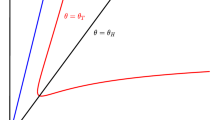Abstract
A simple mathematical model is presented for the population dynamics of fish larvae when the main food supply, in this case copepods, is spatially patchy in its distribution. Encounters by an individual predator (larva) with prey patches, and with individual prey within patches, are represented by Poisson processes. It is demonstrated analytically, and confirmed by numerical experiments, that prey patchiness fails to alter mean predator-prey encounter rates from their values for homogeneous prey distributions. Individual variance in encounter rate is, however, much affected. This has significant consequences for the (small) numbers of larvae surviving to metamorphosis and recruitment to the adult fish population.
Similar content being viewed by others
References
Abraham, E. R. (1998). The generation of plankton patchiness by turbulent stirring. Nature 391, 577–580.
Alcaraz, M. (1997). Copepods under turbulence: grazing, behaviour and metabolic rates. Sci. Marina 61(Suppl. 1), 177–195.
Alvarez, L. H. R. (2000). On the comparative static properties of the expected population density in the presence of stochastic fluctuations. J. Math. Biol. 40, 432–442.
Beyer, J. E. and B. F. Nielsen (1996). Predator foraging in patchy environments: the interrupted poisson process (IPP) model unit. Dana 11, 65–130.
Biktashev, V. N., J. Brindley and J. W. Horwood. Phytoplankton blooms and fish recruitment rate. J. Plankton Res., submitted.
Chambers, R. C. and E. A. Trippel (1997). Early Life History and Recruitment in Fish Populations, London: Chapman and Hall.
Cox, D. R. (1962). Renewal Theory, Monographs on Applied Probability and Statistics, London: Methuen.
Currie, W. J. S., M. R. Claereboudt and J. C. Roff (1998). Gaps and patches in the ocean: a one-dimensional analysis of planktonic distributions. Mar. Ecol. Prog. Ser. 171, 15–21.
Cushing, D. H. and J. W. Horwood (1994). The growth and death of fish larvae. J. Plankton Res. 16, 291–300.
Davis, C. S., G. R. Flierl, P. H. Weibe and P. J. S. Franks (1991). Micropatchiness, turbulence and recruitment in plankton. J. Mar. Res. 49, 109–151.
Fiksen, O., A. C. W. Utne, D. L. Aksnes, K. Eiane, J. V. Helvik and S. Sundby (1998). Modelling the influence of light, turbulence and ontogeny on ingestion rates of larval cod and herring. Fisheries Oceanography 7, 355–363.
Folt, C. L. and C. W. Burns (1999). Biological drivers of zooplankton patchiness. Trends Ecol. Evol. 14, 300–305.
Gerritsen, J. and J. R. Strickler (1977). Encounter probabilities and community structure in zooplankton: a mathematical model. J. Fish. Res. Bd. Can 34, 73–82.
Heath, M. R. and A. Gallego (1998). Bio-physical modelling of the early life stages of haddock, melanogrammus aeglefinus, in the North Sea. Fisheries Oceanography 7, 110–125.
Hill, P. S., A. R. M. Nowell and P. A. Jumars (1992). Encounter rate by turbulent shear of particles similar in diameter to the Kolmogorov scale. J. Mar. Res. 50, 643–668.
Houston, A. I. and J. M. McNamara (1999). Models of Adaptive Behaviour, Cambridge: Cambridge University Press.
Kjorboe, T. (1997). Small-scale turbulence, marine snow formation, and planktivorous feeding. Sci. Marina 61(Suppl. 1), 141–158.
MacKenzie, B. R. and T. Kjorboe (1995). Encounter rates and swimming behaviour of pause-travel and cruise larval fish predators in calm and turbulent laboratory environments. Limnology and Oceanography 40, 1278–1289.
MacKenzie, B. R. and T. Kjorboe (2000). Larval fish feeding and turbulence: A case for the downside. Limnology and Oceanography 45, 1–10.
Pinel Alloul, B. (1995). Spatial heterogeneity as a multiscale characteristic of zooplankton community. Hydrobiologia 300/301, 17–42.
Pitchford, J. W. and J. Brindley. Turbulence, the refuge effect, and fish recruitment. Math. Biosci., submitted.
Powell, T. M. and A. Okubo (1994). Turbulence, diffusion and patchiness in the sea. Phil. Trans. R. Soc. London Ser. B 343, 11–18.
Real, L. A. (1980). Fitness, uncertainty, and the role of diversification in evolution and behaviour. The American Naturalist 115, 623–638.
Rothschild, B. J. and T. R. Osborn (1988). Small scale turbulence and plankton contact rates. J. Plankton Res. 10, 465–474.
Scott, B., G. Marteinsdottir and P. Wright (1999). Potential effects of maternal factors on spawning stock-recruitment relationships under varying fishing pressure. Canadian J. Fisheries and Aquatic Sci. 56, 1882–1890.
Sundby, S. (1997). Turbulence and icthyoplankton: influence on vertical distributions and encounter rates. Sci. Marina 61(Suppl. 1), 159–176.
Tokarev, Y. N., R. Williams and S. A. Piontkovski (1998). Small-scale plankton patchiness in the black sea euphotic layer. Hydrobiologia 375/376, 363–367.
Tsuda, A., H. Sugisaki, T. Ishimaru, T. Saino and T. Sato (1993). White-noise-like distribution of the oceanic copepod neocalanus cristatus in the subarctic North Pacific. Mar. Ecol. Prog. Ser. 97, 39–46.
Visser, A. W. and B. R. Mackenzie (1998). Turbulence-induced contact rates of plankton: the question of scale. Mar. Ecol. Prog. Ser. 166, 307–310.
Author information
Authors and Affiliations
Corresponding author
Rights and permissions
About this article
Cite this article
Pitchford, J.W., Brindley, J. Prey patchiness, predator survival and fish recruitment. Bull. Math. Biol. 63, 527–546 (2001). https://doi.org/10.1006/bulm.2001.0230
Received:
Accepted:
Issue Date:
DOI: https://doi.org/10.1006/bulm.2001.0230




